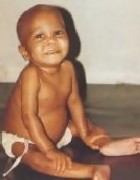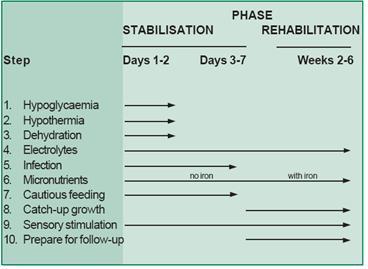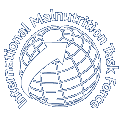Children with severe acute malnutrition who are unwell or have poor appetite, or are under 6 months of age should be admitted for inpatient care. Where no functional systems are in place for community-based care, all children with severe acute malnutrition should be treated as inpatients. Inpatient care may take place in hospitals or Stabilisation Centres.


Above left: child on admisssion; Above right: child 5 weeks later
Click here to find out: What is stabilisation phase
10 steps of routine care
Inpatient treatment takes between 2 to 6 weeks. However, if the necessary community support is available close to where the child lives, they may be discharged early (at step 8) to continue recovery at home.
Routine inpatient treatment is summarised in ’10 steps’:
- Treat/ prevent hypoglycaemia
Treat hypoglycaemia with glucose immediately. To prevent hypoglycaemia, feed malnourished children 2-3 hours day and night. Start straightaway.
- Treat/prevent hypothermia
To treat hypothermia actively re-warm the child. To prevent hypothermia, keep malnourished children warm day and night.
- Treat/prevent dehydration
Too much fluid can kill. Rehydrate more slowly than usual. Do not give IV fluids except in shock.
- Correct electrolyte imbalance
Give extra potassium and magnesium daily. Limit sodium (salt).
- Treat/prevent infection
Give antibiotics routinely to all severely malnourished children to treat hidden infections and prevent death. Wash hands to prevent cross-infection.
- Correct micronutrient deficiencies
Give extra vitamin A, zinc, copper, folic acid and multivitamins. Do not give iron until the child is in the rehabilitation phase.
- Start cautious feeding
Give small amounts of F75 every 3 hours day and night. F75 is a special formula designed to meet the needs of malnourished children.
- Achieve catch-up growth
For rapid weight gain, give as much F100 or ready-to-use therapeutic food (RUTF) as the child can eat, 8 times a day. F100 and RUTF are high in energy and protein.
- Provide sensory stimulation and emotional support
Provide loving care, play and stimulation to improve mental development.
- Prepare for follow-up after recovery
Teach mothers what to feed at home to help the child recover. Malnourished children need regular follow-up to prevent relapse and death.
These steps are accomplished in two phases: an initial stabilisation phase where acute medical conditions are managed, and a longer rehabilitation phase. This is summarised in the table below.

In children with severe malnutrition, emergency treatment of shock and severe anaemia differ from standard treatment.
Click here to find out: How should I treat a severely malnourished child in shock?
Click here to find out: How should I treat a severely malnourished child with severe anaemia?
Download WHO inpatient treatment guidelines
The correct procedures for inpatient treatment are detailed in the “WHO guidelines for inpatient treatment of severely malnourished children”. Click here to download a copy in English, Spanish or French.
The IMTF has created two wall charts that summarise ’10 steps’ of routine care and emergency treatment, based on the WHO guidelines. These can be printed as A2 posters and put on the wall in the hospital. Click here to download the ’10 steps’ wall chart and emergency care wall chart.
See our resources pages for more information on inpatient management.
